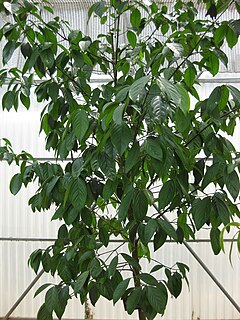
Garcinia is a genus of flowering plants in the family Clusiaceae native to Asia, America, Australia, tropical and southern Africa, and Polynesia. The number of species is disputed; the Kew Gardens recognise up to 400. Commonly, the plants in this genus are called saptrees, mangosteens, garcinias, or monkey fruit.

Xanthone is an organic compound with the molecular formula O[C6H4]2CO. It is a white solid.

Mangostin is a natural xanthonoid, a type of organic compound isolated from various parts of the mangosteen tree. It is a yellow crystalline solid with a xanthone core structure. Mangostin and a variety of other xanthonoids from mangosteen have been investigated for biological properties including antioxidant, anti-bacterial, anti-inflammatory, and anticancer activities.

Malvin is a naturally occurring chemical of the anthocyanin family.
Neoflavonoids are a class of polyphenolic compounds. While flavonoids have the 2-phenylchromen-4-one backbone, neoflavonoids have the 4-phenylchromen backbone with no hydroxyl group substitution at position 2.

Garcinia morella is a species of tree in the family Clusiaceae found in India, and Sri Lanka.

Hypericum androsaemum, also referred to as Tutsan, Shrubby St. John's Wort, or sweet-amber, is a flowering plant in the family Hypericaceae. It is a perennial shrub reaching up to 70 cm in height, native to open woods and hillsides in Eurasia.

Neohesperidose is the disaccharide which is present in some flavonoids. It can be found in species of Typha.

Mangiferin is a xanthonoid. This molecule is a glucoside of norathyriol.

Benzoyl-CoA is a molecule implied in the activity of the different enzymes 4-hydroxybenzoyl-CoA reductase, benzoyl-CoA reductase, benzoyl-CoA 3-monooxygenase, benzoate-CoA ligase, 2alpha-hydroxytaxane 2-O-benzoyltransferase, anthranilate N-benzoyltransferase, biphenyl synthase, glycine N-benzoyltransferase, ornithine N-benzoyltransferase and phenylglyoxylate dehydrogenase (acylating).
Psoralea plicata is a herb species in the genus Psoralea found in Pakistan.

Garcinia hanburyi is a plant species in the genus Garcinia, the gamboge trees.
Swertia punicea is a plant species in the genus Swertia.

Violdelphin is an anthocyanin, a plant pigment, has been found in the purplish blue flower of Aconitum chinense, in the blue flowers in the genus Campanula and in the blue flowers of Delphinium hybridum. It is a flavenoid natural product, incorporating two p-hydroxy benzoic acid residues, one rutinoside and two glucosides associated with a delphinidin.

Lunularin is a dihydrostilbenoid found in common celery. It has also been found in the roots of Hydrangea macrophylla.

Hypericum mysorense is a species of flowering plant in the Hypericaceae family. It is primarily found at high elevations in the Western Ghats of India and the mountains of Sri Lanka, but was also reported from Socoro by Isaac Bayley Balfour in the 19th century. It was studied to improve understanding of endosperm formation in Hypericum, and the identification of a number of xanthone derivatives from this species contributed to the chemotaxonomic description of subfamily Hypericoideae.

Hypericum ericoides is a dwarf shrub in the flowering plant family Hypericaceae, section Coridium. It is found in eastern and southeastern Spain, Morocco, and Tunisia. Its preferred habitat is fissures in calcareous rocks in warm, sunny places, from 200 to 2,000 meters above sea level (MASL).

Ploiarium is a genus of three species of woody plants in the family Bonnetiaceae. It is native to tropical forests and peat swamp forests in Southeast Asia including southern Indochina, Malay Peninsula, Sumatra, and Borneo. Species are generally slow growing with irregular flowering and fruiting cycles. Colonization of plants by arbuscular mycorrhizal fungi is known to improve growth and biomass.
Garcinia forbesii, commonly known as the rose kandis or just kandis, is a small to medium sized tree in the family Clusiaceae or Guttiferae. The specific epithet (forbesii) honors Scottish naturalist Henry Ogg Forbes.

Garcinia pseudoguttifera, known as the mo'onia tree in its native range, is a species of flowering tree in the family Clusiaceae or Guttiferae.
















